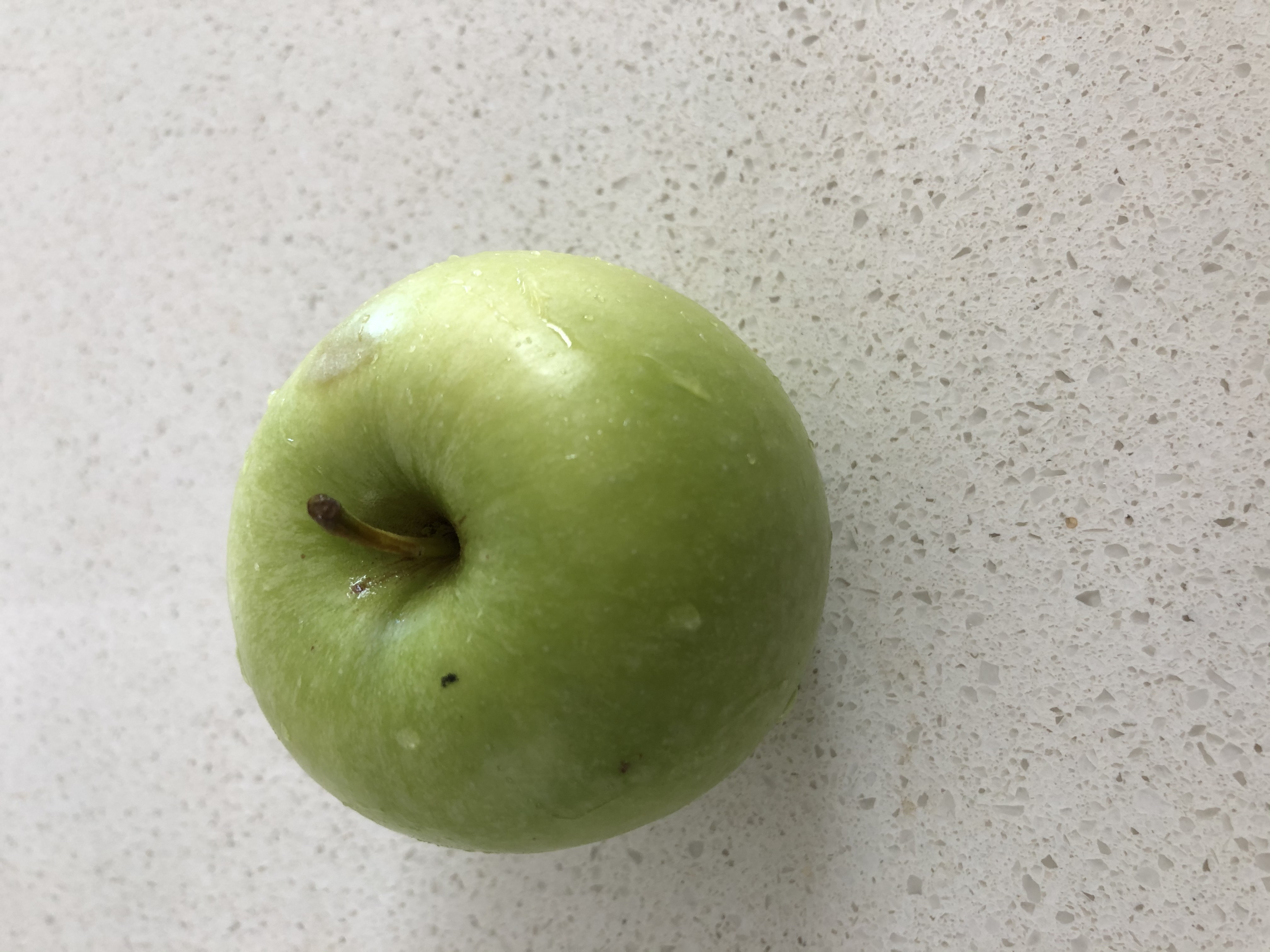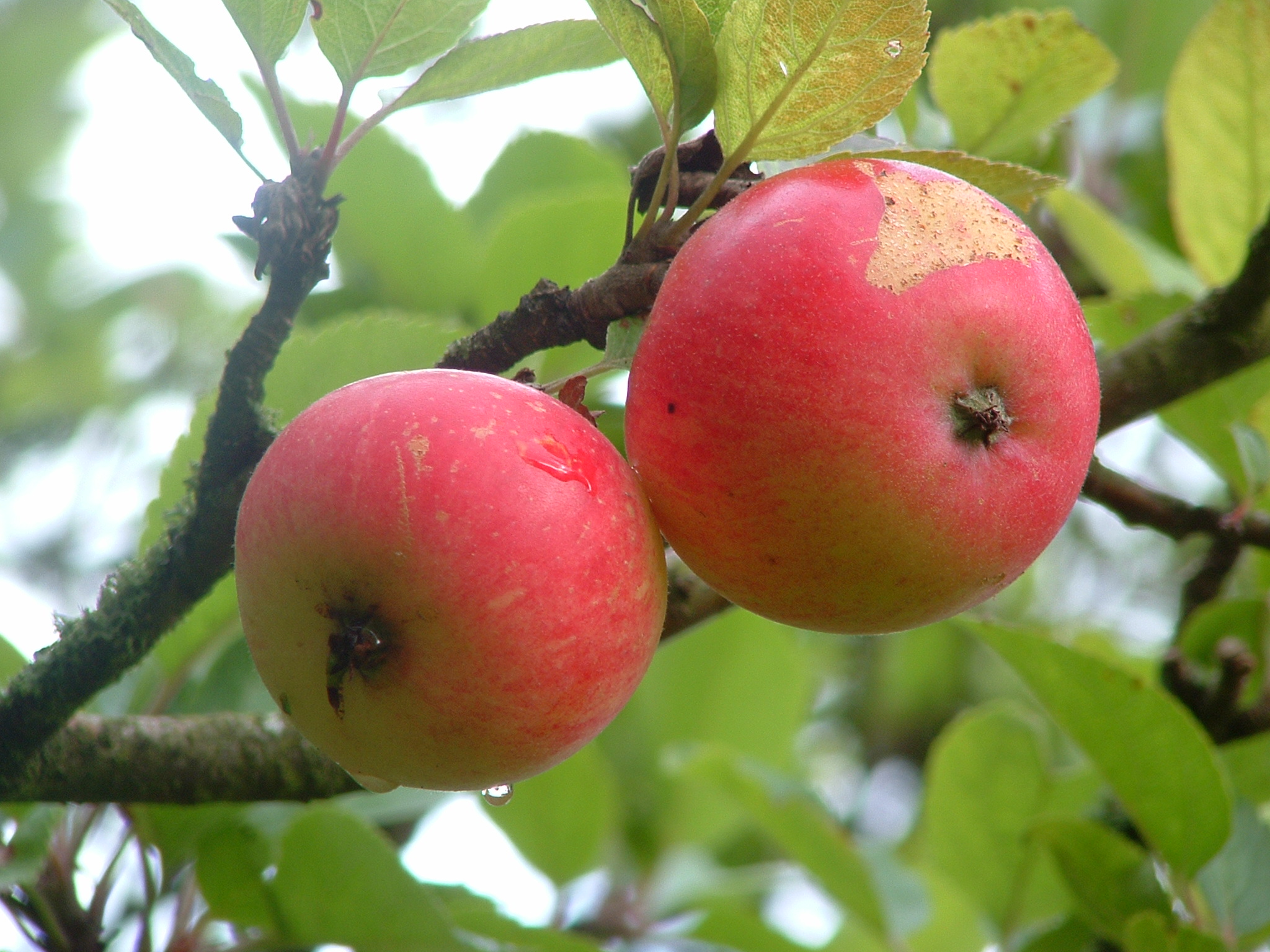|
Belle De Boskoop
Belle de Boskoop (also called Goudrenet, Goudreinet or Goudreinnette) is an apple cultivar which originated in Boskoop, Netherlands, where it began as a chance seedling in 1856. Variants include Boskoop red, yellow and green. This rustic apple is firm, tart and fragrant. Greenish-gray tinged with red, the apple stands up well to cooking. Generally Boskoop varieties are very high in acid content and can contain more than four times the vitamin C of Granny Smith or Golden Delicious. The apple grows well in Normandy, France. File:Belle de Boskoop Flowers.JPG, 'Belle de Boskoop' apple flowers File:Blossoming Belle de Boskoop apple tree.JPG, Blossoming 'Belle de Boskoop' apple tree File:Jabuka crveni boskoop.jpg, Ripe 'Red Boskoop' on a branch Culture The cultivar is compatible with most rootstocks, but its pollen quality is poor because it is a triploid. Cultivars that can provide compatible pollen for 'Belle de Boskoop' include Discovery Discovery may refer to: * Discovery ( ... [...More Info...] [...Related Items...] OR: [Wikipedia] [Google] [Baidu] |
Chance Seedling
A chance seedling is a plant that is the product of unintentional breeding. Identifying the parent plants of a chance seedling may be difficult. It may be necessary to genetically analyse the seedling and surrounding plants to be sure. Plants that come from the artificial union of gametes from a maternal and paternal source are not chance seedlings. A chance seedling may be a genetically unique individual with desirable characteristics that is then intentionally bred. The Kindred Spirit Hybrid Oak and the Granny Smith, Wolf River, Lady Alice, Red Delicious, Gravenstein, Braeburn, Samarbehisht Chausa, Calville Blanc d'hiver, Belle de Boskoop and Baldwin apples are examples of varieties that started with chance seedlings that were selected and assigned cultivar status owing to their desirable properties. See also *Volunteer (botany) In gardening and agronomic terminology, a volunteer is a plant that grows on its own, rather than being deliberately planted by a farmer or gardener ... [...More Info...] [...Related Items...] OR: [Wikipedia] [Google] [Baidu] |
Boskoop
Boskoop () is a town in the province of South Holland. It was a separate municipality until it merged into Alphen aan den Rijn in 2014. The town had a population of 15,050 in 2012 and covers an area of of which is water. It's the world's biggest joined floriculture area. Boskoop is famous for its nurseries, particularly woody plant and perennial nurseries, of which some 774 are situated on long stretches of land, divided by narrow canals. Before World War II almost all transport was conducted using narrow boats. A few exceptionally high footbridges crossing some of the broader (main) canals remain from these days. Between the World Wars the transition was made from fruit culture to decorative garden plants and trees. As a source of technical knowledge about the art of growing decorative plants, Boskoop remains world-renowned and unique. The name "Boskoop" has been given to an apple cultivar (Belle de Boskoop) which is widely distributed in the Low Countries, to a grape variety ... [...More Info...] [...Related Items...] OR: [Wikipedia] [Google] [Baidu] |
Netherlands
) , anthem = ( en, "William of Nassau") , image_map = , map_caption = , subdivision_type = Sovereign state , subdivision_name = Kingdom of the Netherlands , established_title = Before independence , established_date = Spanish Netherlands , established_title2 = Act of Abjuration , established_date2 = 26 July 1581 , established_title3 = Peace of Münster , established_date3 = 30 January 1648 , established_title4 = Kingdom established , established_date4 = 16 March 1815 , established_title5 = Liberation Day (Netherlands), Liberation Day , established_date5 = 5 May 1945 , established_title6 = Charter for the Kingdom of the Netherlands, Kingdom Charter , established_date6 = 15 December 1954 , established_title7 = Dissolution of the Netherlands Antilles, Caribbean reorganisation , established_date7 = 10 October 2010 , official_languages = Dutch language, Dutch , languages_type = Regional languages , languages_sub = yes , languages = , languages2_type = Reco ... [...More Info...] [...Related Items...] OR: [Wikipedia] [Google] [Baidu] |
Apple
An apple is an edible fruit produced by an apple tree (''Malus domestica''). Apple fruit tree, trees are agriculture, cultivated worldwide and are the most widely grown species in the genus ''Malus''. The tree originated in Central Asia, where its wild ancestor, ''Malus sieversii'', is still found today. Apples have been grown for thousands of years in Asia and Europe and were brought to North America by European colonization of the Americas, European colonists. Apples have Religion, religious and mythology, mythological significance in many cultures, including Norse mythology, Norse, Greek mythology, Greek, and Christianity in Europe, European Christian tradition. Apples grown from seed tend to be very different from those of their parents, and the resultant fruit frequently lacks desired characteristics. Generally, apple cultivars are propagated by clonal grafting onto rootstocks. Apple trees grown without rootstocks tend to be larger and much slower to fruit after plantin ... [...More Info...] [...Related Items...] OR: [Wikipedia] [Google] [Baidu] |
Cultivar
A cultivar is a type of cultivated plant that people have selected for desired traits and when propagated retain those traits. Methods used to propagate cultivars include: division, root and stem cuttings, offsets, grafting, tissue culture, or carefully controlled seed production. Most cultivars arise from purposeful human manipulation, but some originate from wild plants that have distinctive characteristics. Cultivar names are chosen according to rules of the International Code of Nomenclature for Cultivated Plants (ICNCP), and not all cultivated plants qualify as cultivars. Horticulturists generally believe the word ''cultivar''''Cultivar'' () has two meanings, as explained in ''Formal definition'': it is a classification category and a taxonomic unit within the category. When referring to a taxon, the word does not apply to an individual plant but to all plants that share the unique characteristics that define the cultivar. was coined as a term meaning "cultivated variety ... [...More Info...] [...Related Items...] OR: [Wikipedia] [Google] [Baidu] |
Granny Smith
The Granny Smith, also known as a green apple or sour apple, is an apple cultivar which originated in Australia in 1868. It is named after Maria Ann Smith, who propagated the cultivar from a chance seedling. The tree is thought to be a hybrid of ''Malus sylvestris'', the European wild apple, with the domesticated apple ''Malus domestica'' as the polleniser. The fruit is hard, firm and with a light green skin and crisp, juicy flesh. The flavour is tart and acidic. It remains firm when baked, making it a popular cooking apple used in pies, where it can be sweetened. The apple goes from being completely green to turning yellow when overripe. The US Apple Association reported in 2019 that the Granny Smith was the third most popular apple in the United States of America. History The Granny Smith cultivar originated in Eastwood, New South Wales, Australia (now a suburb of Sydney) in 1868. Its discoverer, Maria Ann Smith (née Sherwood), had emigrated to the district from Beckley, ... [...More Info...] [...Related Items...] OR: [Wikipedia] [Google] [Baidu] |
Golden Delicious
'Golden Delicious' is a cultivar of apple. It is one of the 15 most popular apple cultivars in the United States. It is not closely related to 'Red Delicious'. History Golden Delicious arose from a chance seedling, possibly a hybrid of 'Grimes Golden' and 'Golden Reinette'. The original tree was found on the Mullins' family farm in Clay County, West Virginia, United States, and was locally known as Mullin's Yellow Seedling and Annit apple. In Clay County, George Deems was instrumental in preserving and perpetuating the original Stark's Golden delicious apple tree on A. H. Mullins property back in 1938. The famed tree came to the attention of the Stark Brothers a number of years before, when Mr. Mullins sent three apples to Mr. Stark one fine April. The Golden Delicious' long keeping qualities were soon abundantly evident to Mr. Stark, as well as to United States Pomologist Colonel Brackett, in Washington, and the nursery bought the tree and ground on which it stands from Mr. ... [...More Info...] [...Related Items...] OR: [Wikipedia] [Google] [Baidu] |
Rootstocks
A rootstock is part of a plant, often an underground part, from which new above-ground growth can be produced. It could also be described as a stem with a well developed root system, to which a bud from another plant is grafted. It can refer to a rhizome or underground stem. In grafting, it refers to a plant, sometimes just a stump, which already has an established, healthy root system, onto which a cutting or a bud from another plant is grafted. In some cases, such as vines of grapes and other berries, cuttings may be used for rootstocks, the roots being established in nursery conditions before planting them out. The plant part grafted onto the rootstock is usually called the scion. The scion is the plant that has the properties that propagator desires above ground, including the photosynthetic activity and the fruit or decorative properties. The rootstock is selected for its interaction with the soil, providing the roots and the stem to support the new plant, obtaining the necessa ... [...More Info...] [...Related Items...] OR: [Wikipedia] [Google] [Baidu] |
Triploid
Polyploidy is a condition in which the cells of an organism have more than one pair of ( homologous) chromosomes. Most species whose cells have nuclei ( eukaryotes) are diploid, meaning they have two sets of chromosomes, where each set contains one or more chromosomes and comes from each of two parents, resulting in pairs of homologous chromosomes between sets. However, some organisms are polyploid. Polyploidy is especially common in plants. Most eukaryotes have diploid somatic cells, but produce haploid gametes (eggs and sperm) by meiosis. A monoploid has only one set of chromosomes, and the term is usually only applied to cells or organisms that are normally diploid. Males of bees and other Hymenoptera, for example, are monoploid. Unlike animals, plants and multicellular algae have life cycles with two alternating multicellular generations. The gametophyte generation is haploid, and produces gametes by mitosis, the sporophyte generation is diploid and produces spores by ... [...More Info...] [...Related Items...] OR: [Wikipedia] [Google] [Baidu] |
Discovery (apple)
'Discovery' is an early season dessert apple cultivar. One of its parents was the 'Worcester Pearmain', with the pollinator thought to possibly be ' Beauty of Bath'.Morgan, J. & Richards, A. (Illus. Dowle, E.) (2002), ''The New Book of Apples'', History 'Discovery' was first introduced to the market by the Suffolk nurseryman Jack Matthews. In around 1949, George Dummer, a fruit farm worker from Blacksmiths Corner, Langham, Essex, raised several apple seedlings from an open-pollinated 'Worcester Pearmain'.Morgan & Richards, 2002, p. 201Ketch, D. ''et al'', ''The Common Ground Book of Orchards'', London: Common Ground, 2000, p.108 He decided to transplant the best of the apples into his front garden, although the young tree was left unplanted and exposed to frost, wrapped only in sacking, for several months due to a family accident.Starkey, S. ''Discovering the Discovery apple'', ''The Nottingham Post'', 6-09-14Morgan & Richards, 2002, p. 201 The tree survived and later came to t ... [...More Info...] [...Related Items...] OR: [Wikipedia] [Google] [Baidu] |
James Grieve Apple
James Grieve is an old variety of apple. It gets its name from its breeder, James Grieve, who raised the apple from pollination of a Pott's Seedling or a Cox's Orange Pippin apple (most likely both) in Edinburgh, Scotland some time before 1893. This is a savoury, juicy apple with strong acidity at first, which then mellows as the fruit matures during September, but the flesh softens soon thereafter. When picked early, it makes a sweet and delicate stewed apple, but then can be used as a dessert apple. James Grieve apples used to be grown all over Europe and were delivered to the city markets via train or horse-and-cart, but because they bruised easily they had to be carefully packed in laundry-type wicker baskets filled with straw. The fruit cannot sustain modern supermarket handling, and so they are now only grown in gardens and for direct sale to consumers. Nonetheless, James Grieve is considered a good apple because it is exceptionally tasty, it produces fruit every year, ... [...More Info...] [...Related Items...] OR: [Wikipedia] [Google] [Baidu] |
Melba (apple)
Melba is a Canadian cultivar of domesticated apple, which was developed by W. T. Macoun at the Central Experimental Farm, in Ottawa, Ontario by crossing a McIntosh with a Liveland Raspberry apple. It has a yellow skin washed with crimson colour. Flesh is extremely white, firm and crisp. Flavor is sweet with hints of tart. There is also a Red Melba mutation which is more red coloured, and is ripening later in season. This tree is very productive and can bear fruit at a young age, but has a biennial tendency Biennial bearing (or alternate) bearing is a term used in pomology to refer to trees that have an irregular crop load from year to year. In the "on" year too much fruit is set, leading to small fruit size. Excess weight in the main branches can be ... and early harvest. Need high skill gardening but highly rewarded. It is mainly used for fresh eating. Sunday, 25 September 2022 Gallery File:Pomological Watercolor POM00002873.jpg, US Department of Agriculture watercolor F ... [...More Info...] [...Related Items...] OR: [Wikipedia] [Google] [Baidu] |


.jpg)


